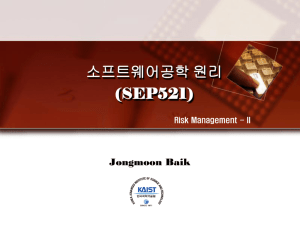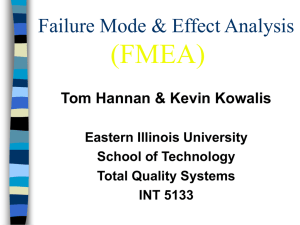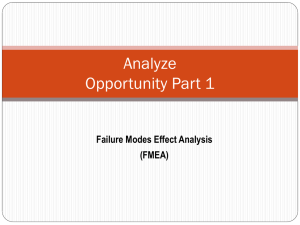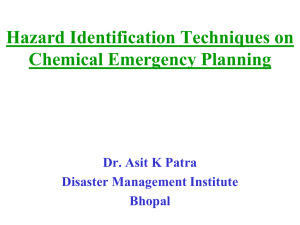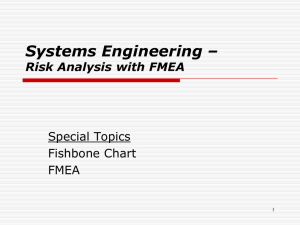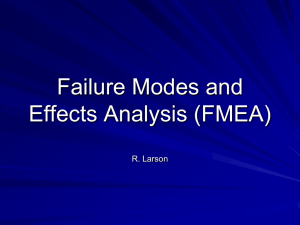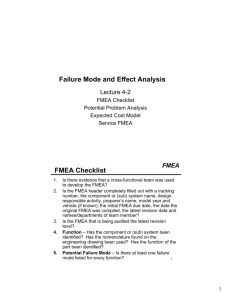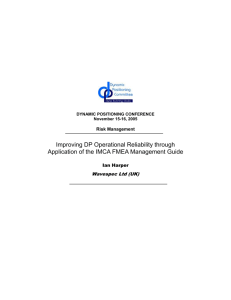1)Failure Mode & Effects Analysis (FMEA) Defined: FMEA is a
advertisement
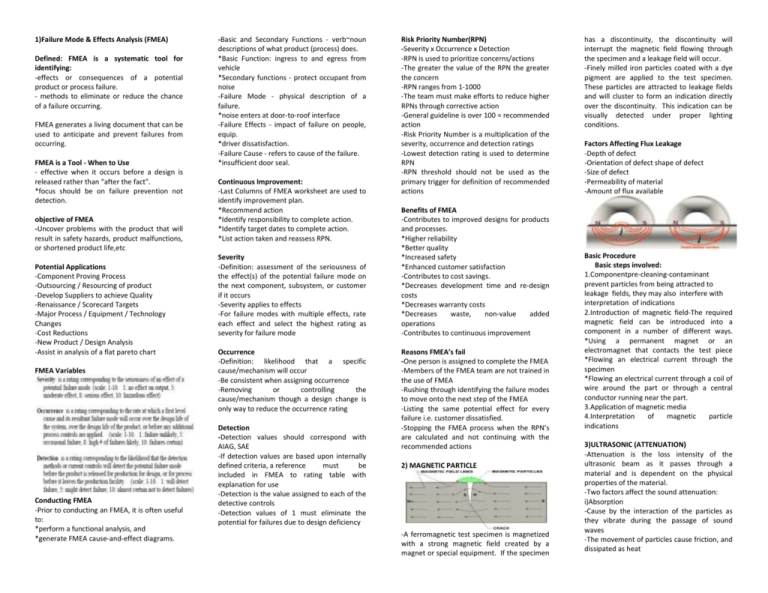
1)Failure Mode & Effects Analysis (FMEA) Defined: FMEA is a systematic tool for identifying: -effects or consequences of a potential product or process failure. - methods to eliminate or reduce the chance of a failure occurring. FMEA generates a living document that can be used to anticipate and prevent failures from occurring. FMEA is a Tool - When to Use - effective when it occurs before a design is released rather than “after the fact”. *focus should be on failure prevention not detection. objective of FMEA -Uncover problems with the product that will result in safety hazards, product malfunctions, or shortened product life,etc Potential Applications -Component Proving Process -Outsourcing / Resourcing of product -Develop Suppliers to achieve Quality -Renaissance / Scorecard Targets -Major Process / Equipment / Technology Changes -Cost Reductions -New Product / Design Analysis -Assist in analysis of a flat pareto chart FMEA Variables Conducting FMEA -Prior to conducting an FMEA, it is often useful to: *perform a functional analysis, and *generate FMEA cause-and-effect diagrams. -Basic and Secondary Functions - verb~noun descriptions of what product (process) does. *Basic Function: ingress to and egress from vehicle *Secondary functions - protect occupant from noise -Failure Mode - physical description of a failure. *noise enters at door-to-roof interface -Failure Effects - impact of failure on people, equip. *driver dissatisfaction. -Failure Cause - refers to cause of the failure. *insufficient door seal. Continuous Improvement: -Last Columns of FMEA worksheet are used to identify improvement plan. *Recommend action *Identify responsibility to complete action. *Identify target dates to complete action. *List action taken and reassess RPN. Severity -Definition: assessment of the seriousness of the effect(s) of the potential failure mode on the next component, subsystem, or customer if it occurs -Severity applies to effects -For failure modes with multiple effects, rate each effect and select the highest rating as severity for failure mode Occurrence -Definition: likelihood that a specific cause/mechanism will occur -Be consistent when assigning occurrence -Removing or controlling the cause/mechanism though a design change is only way to reduce the occurrence rating Detection -Detection values should correspond with AIAG, SAE -If detection values are based upon internally defined criteria, a reference must be included in FMEA to rating table with explanation for use -Detection is the value assigned to each of the detective controls -Detection values of 1 must eliminate the potential for failures due to design deficiency Risk Priority Number(RPN) -Severity x Occurrence x Detection -RPN is used to prioritize concerns/actions -The greater the value of the RPN the greater the concern -RPN ranges from 1-1000 -The team must make efforts to reduce higher RPNs through corrective action -General guideline is over 100 = recommended action -Risk Priority Number is a multiplication of the severity, occurrence and detection ratings -Lowest detection rating is used to determine RPN -RPN threshold should not be used as the primary trigger for definition of recommended actions Benefits of FMEA -Contributes to improved designs for products and processes. *Higher reliability *Better quality *Increased safety *Enhanced customer satisfaction -Contributes to cost savings. *Decreases development time and re-design costs *Decreases warranty costs *Decreases waste, non-value added operations -Contributes to continuous improvement Reasons FMEA’s fail -One person is assigned to complete the FMEA -Members of the FMEA team are not trained in the use of FMEA -Rushing through identifying the failure modes to move onto the next step of the FMEA -Listing the same potential effect for every failure i.e. customer dissatisfied. -Stopping the FMEA process when the RPN’s are calculated and not continuing with the recommended actions 2) MAGNETIC PARTICLE -A ferromagnetic test specimen is magnetized with a strong magnetic field created by a magnet or special equipment. If the specimen has a discontinuity, the discontinuity will interrupt the magnetic field flowing through the specimen and a leakage field will occur. -Finely milled iron particles coated with a dye pigment are applied to the test specimen. These particles are attracted to leakage fields and will cluster to form an indication directly over the discontinuity. This indication can be visually detected under proper lighting conditions. Factors Affecting Flux Leakage -Depth of defect -Orientation of defect shape of defect -Size of defect -Permeability of material -Amount of flux available Basic Procedure Basic steps involved: 1.Componentpre-cleaning-contaminant prevent particles from being attracted to leakage fields, they may also interfere with interpretation of indications 2.Introduction of magnetic field-The required magnetic field can be introduced into a component in a number of different ways. *Using a permanent magnet or an electromagnet that contacts the test piece *Flowing an electrical current through the specimen *Flowing an electrical current through a coil of wire around the part or through a central conductor running near the part. 3.Application of magnetic media 4.Interpretation of magnetic particle indications 3)ULTRASONIC (ATTENUATION) -Attenuation is the loss intensity of the ultrasonic beam as it passes through a material and is dependent on the physical properties of the material. -Two factors affect the sound attenuation: i)Absorption -Cause by the interaction of the particles as they vibrate during the passage of sound waves -The movement of particles cause friction, and dissipated as heat -As the frequency increases, the absorption greater due to raid movement ii)Scatter -Cause by grain boundaries, porosity, non metallic inclusions, etc -Larger grain size greater scattering -Coarse grain will be more attenuative than fine grain material -Rough surface also cause attenuation. Attenuation can be represented as a decaying exponential. The amplitude change of a decaying plane wave can be expressed as -A0 is the unattenuated amplitude of the propagating wave at some location. -The amplitude A is the reduced amplitude after the wave has traveled a distance z from that initial location. -The quantity is the attenuation coefficient of the wave traveling in the z-direction. The dimensions of are nepers/length, where a neper is a dimensionless quantity. -Attenuation can also measured in terms of decibels (dB) dB = 20 log (I0/I) 4)FAILURE ANALYSIS refer to slides 9(failure) i) Fracture: in 3 general ways: -sudden brittle fracture - fatigue / progressive fracture -delayed fractured Macroscopic fracture –Brittle: fracture on a plane normal to principal stress –Ductile : involves flow on planes of maximum shear (planes at 45 to the load). Theory of brittle fracturechapter 9 Griffith theory -By using the concept of energy balance in order to explain discrepancy between the theoretical cohesive strength& observed the fracture strength of ideally brittle material . existing crack will propagate when the released elastic strain energy is at least equal to the energy required to create new crack surface. • Decrease in strain energy results from the formation of of a crack • Elastic strain energy/plate thickness UE= πa2s2/E (crack releases strain energy) • Surface energy presence of the crack US= 4aƔs • Total change in potential energy U= UE+ US d U/da =0=d(4as - πa2s2/E)/da Fracture Modes •Simple fracture is the separation of a body into 2 or more pieces in response to an applied stress that is static (constant) and at temperatures that are low relative to the Tmof the material. •Classification is based on the ability of a material to experience plastic deformation. •Ductile fracture –Accompanied by significant plastic deformation •Brittle fracture –Little or no plastic deformation –Sudden, catastrophic Fracture Mechanism Imposed stress-> Crack Initiation ->Crack Propagation •Ductile failure has extensive plastic deformation in the vicinity of the advancing crack. The process proceeds relatively slow (stable). The crack resists any further extension unless there is an increase in the applied stress. •In brittle failure, cracks may spread very rapidly, with little deformation. These cracks are more unstable and crack propagation will continue without an increase in the applied stress. FA: Thermal Corrosion Oxidation Fatigue Induce Cracking Please refer to the slide:9,10,11 n12


